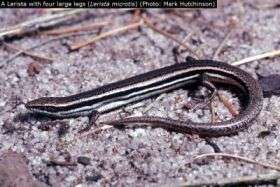Limb loss in lizards -- evidence for rapid evolution

Small skink lizards, Lerista, demonstrate extensive changes in body shape over geologically brief periods. Research published in the open access journal BMC Evolutionary Biology shows that several species of these skinks have rapidly evolved an elongate, limbless body form.
Skinks are a common sight in Australia and many species have limbs that are either reduced or missing entirely. According to the lead author of this study, Adam Skinner of The University of Adelaide, "It is believed that skinks are loosing their limbs because they spend most of their lives swimming through sand or soil; limbs are not only unnecessary for this, but may actually be a hindrance".
Skinner and his colleagues performed a genetic analysis of the lizards to investigate the pattern and rate of limb reduction, finding that evolution of a snake-like body form has occurred not only repeatedly but also very rapidly and without any evidence of reversals. Skinner said, "At the highest rate, complete loss of limbs is estimated to have occurred within 3.6 million years". Compared to similarly dramatic evolutionary changes in other animals, this is blisteringly fast.
Citation: Rapid and repeated limb loss in a clade of scincid lizards, Adam Skinner, Michael S Y Lee and Mark N Hutchinson, BMC Evolutionary Biology (in press) www.biomedcentral.com/bmcevolbiol/
Source: BioMed Central

















